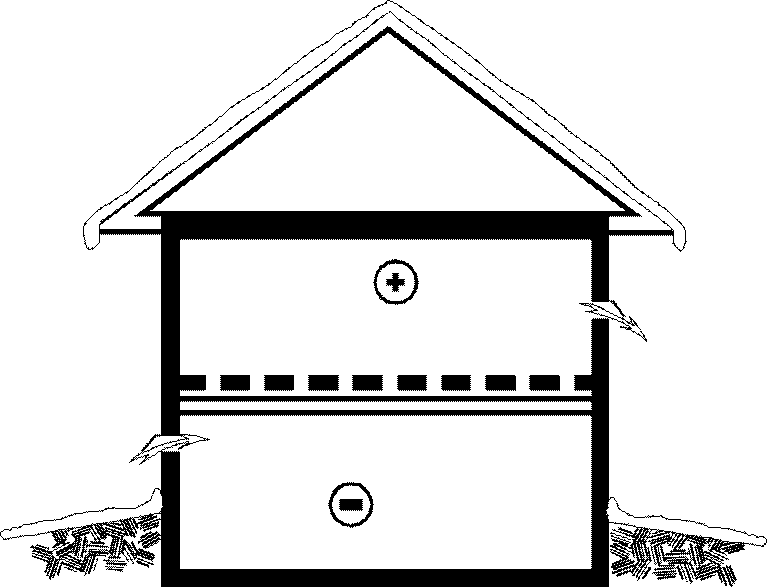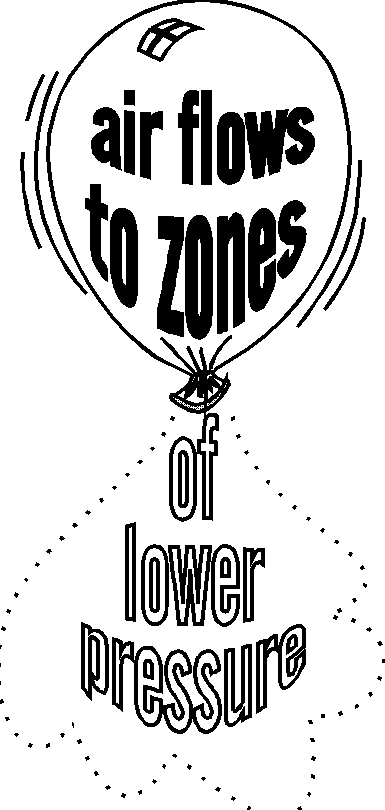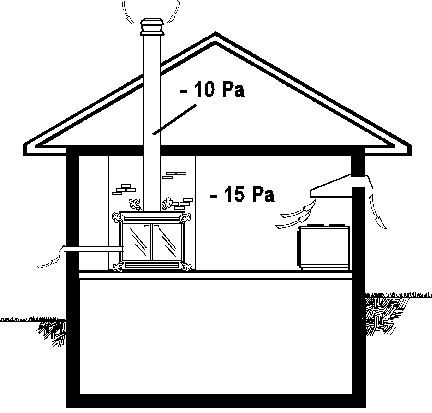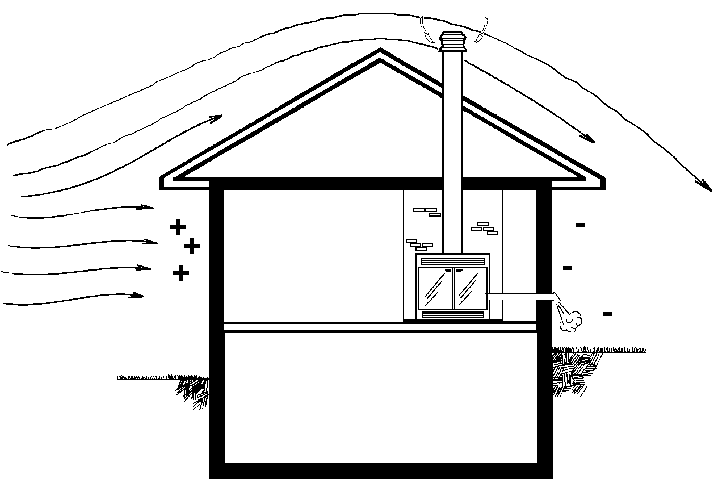The combustion air supply |
|||||||||||||||||||||||||||||||||||||||||||||||||||||||||||||||||
theoretical draft - depressurization = net draft Building depressurization competes directly with chimney draft. If the chimney wins the competition, the flow direction is up (successful venting); if the fan causing the depressurization wins, the flow is down (spillage or backdrafting). Several years ago, when large exhaust systems—like downdraft kitchen range exhausts—began to cause spillage from fireplaces in reasonably tight houses, a consensus briefly formed around the idea of bringing combustion air from outdoors. The theory was that the flow of air from outdoors would be free of influence from building pressure, allowing the combustion appliance to get the air it needed. In the late 1980s such certainty existed among technologists and regulatory authorities on the issue of outdoor combustion air that it was made mandatory in some building codes. Unfortunately, the decision to enforce mandatory outdoor air requirements was made before research was done to investigate how these air supplies actually work. The idea that spillage from combustion systems can be reduced or eliminated by providing a supply of outdoor air to the appliance is not supported by research results. Laboratory and field reports have revealed that providing outdoor air is not a simple or effective cure for spillage, and that some designs could create a fire hazard. Two forms of outdoor air supply have been used: passive make-up type air supplies and direct-to-combustion chamber air supplies. Passive make-up air suppliesA passive make-up type air supply is one that is not connected directly to the appliance combustion chamber. Since it is connected only to the house environment and not to the appliance, it flows air into a house only when the pressure inside is lower than the pressure outdoors at the duct weatherhood.
More importantly, it is misleading to think of the hole in the wall approach as supplying combustion air. In fact, passive air supplies provide air only in response to pressure differences. In cold weather, if a passive make-up air supply is located below the neutral pressure plane of the house (and there is no wind effect and no exhaust systems are operating), air will flow into the house. If, on the other hand, the passive inlet is located above the house neutral pressure plane, air will flow out. It is useful to keep in mind a key physical principle: AIR FLOWS TO ZONES OF LOWER PRESSURE through any available opening.
Direct combustion air suppliesResearch has shown that properly sized air supplies routed from outside directly to a fireplace or stove combustion chamber can supply the total combustion air requirements after the system has reached operating temperature, provided the firebox is sealed tightly from the room with gasketed glass doors. However, two key findings from the research serve as cautions against the widespread use of direct combustion air supplies.
2. Direct air supplies can reverse flow direction if the weatherhood is exposed to a negative pressure in excess of chimney draft. Hot exhaust gas passing through a combustion air duct constitutes a potential fire hazard. The pressure effects of wind force around buildings can be far more powerful than the pressures produced by chimney draft. Chimney draft ranges from zero to about 50 Pa in normal residential installations, whereas high wind effects can produce pressures around houses up to 100 Pa.
When a strong wind creates a negative pressure zone around a combustion air supply inlet, it may overcome chimney draft and cause a reversal of gas flow. Evidence of wind-induced reversals in combustion air ducts is becoming more common now that so many systems have been installed. When diagnosing venting problems in systems with direct outdoor combustion air ducts, look for soot or staining inside the duct. If there is any evidence of reversal, disconnect the duct and plug the hole in the house envelope. It has been suggested that a direct combustion air supply to a woodburning appliance would eliminate its air consumption impact on other chimney vented combustion equipment in the building. However, when their doors are closed, most woodburning appliances exhaust comparatively little air from the dwelling (see Table 2), so the risk of reversal of a ducted combustion air supply usually outweighs any advantage gained by bringing air from outdoors. An open fireplace, in contrast, can exhaust such a large volume of air that it could affect the operation of, for example, a conventional gas-fired furnace or water heater. But direct combustion air supplies cannot effectively be connected to a fireplace without doors because insufficient pressure difference is created to drive the flow. Other strategies are required to deal with the impact of open fireplaces on the operation of spillage-susceptible chimney vented equipment in the building. (See Spillage from open fireplaces.) There may be circumstances in which a direct outdoor air supply is considered necessary. If it is decided to supply combustion air directly to a firebox, it should be done with full awareness that spillage is still likely if the room becomes seriously depressurized and, for safety reasons, steps should be taken to control temperatures on combustibles adjacent to the air supply duct in case wind effects lead to a flow reversal. Despite the fact that it is enshrined in some building codes and its adherents are often vocally forceful, there is no scientific evidence to suggest that outdoor air supplies, either direct to the combustion chamber or indirect supplies to the living space, are reliable and effective remedial measures for combustion spillage from the appliance for which the supply is intended. The house as a combustion air supply chamberA hearth vented by natural draft needs a reliable and unrestricted supply of combustion air. Since passive outdoor air supplies in reasonable sizes are ineffective and since direct combustion air supplies are unreliable and potentially dangerous, other options must be considered. The most obvious alternative to outdoor air is to take combustion air from inside the building. The advantage of taking combustion air directly from the room in which the appliannce is installed is that the building envelope moderates the effect of wind on the air supply by damping out wind-induced pressure fluctuations. The pressure inside the house will still be affected by wind to some extent, but the flow resistance offered by the envelope tends to remove the peaks and valleys of high and low pressure caused by wind gusts. The main disadvantage of taking air from inside the house is that the pressure environment can be adversely affected by powered exhausts. However, depressurization caused by powered exhaust flows is predictable and manageable, unlike the more random and unpredictable effects of wind on outdoor air supplies. The worst-case indoor air pressure environment can be measured using the house pressure test described later, and can be controlled either by limiting exhaust flows or by installing a powered make-up air system. In general, therefore, hearths that are vented by natural chimney draft should draw the air for combustion from the room in which they are located. Where necessary the indoor air pressure should be controlled to minimize depressurization.
Summary
|
|||||||||||||||||||||||||||||||||||||||||||||||||||||||||||||||||



